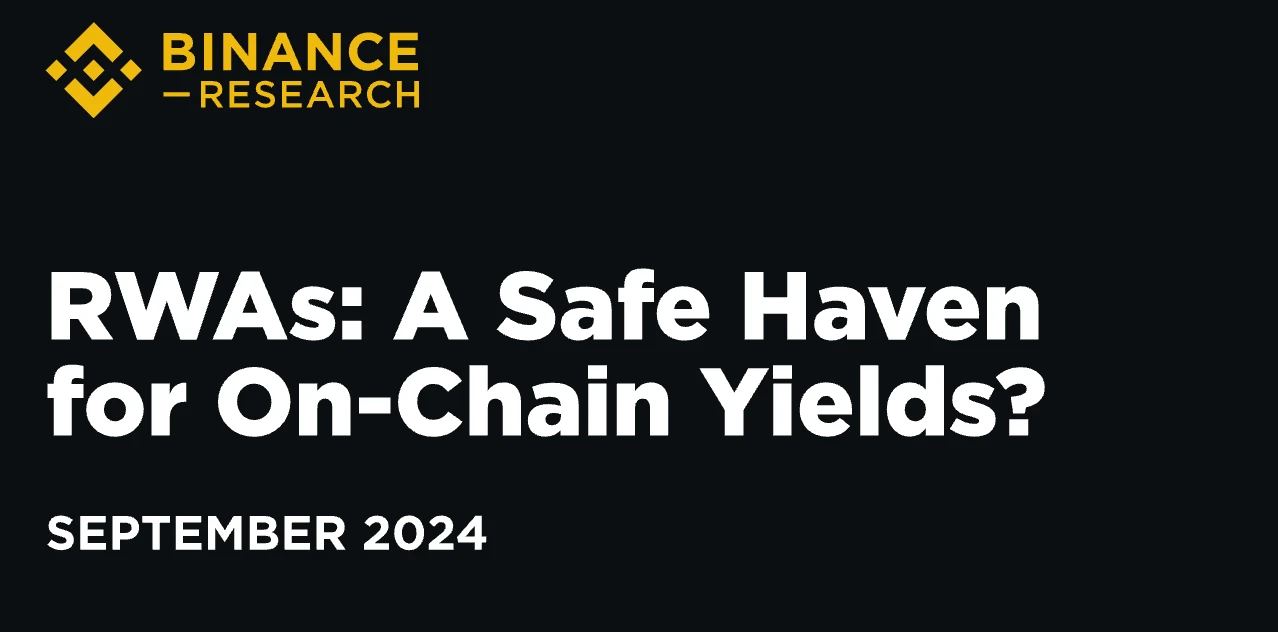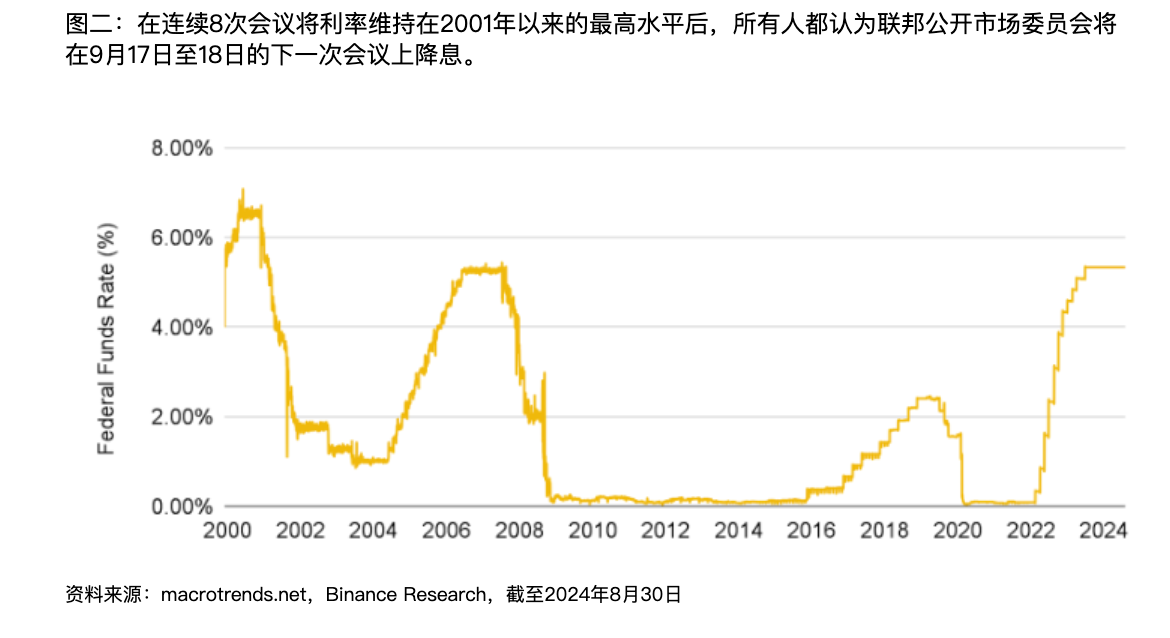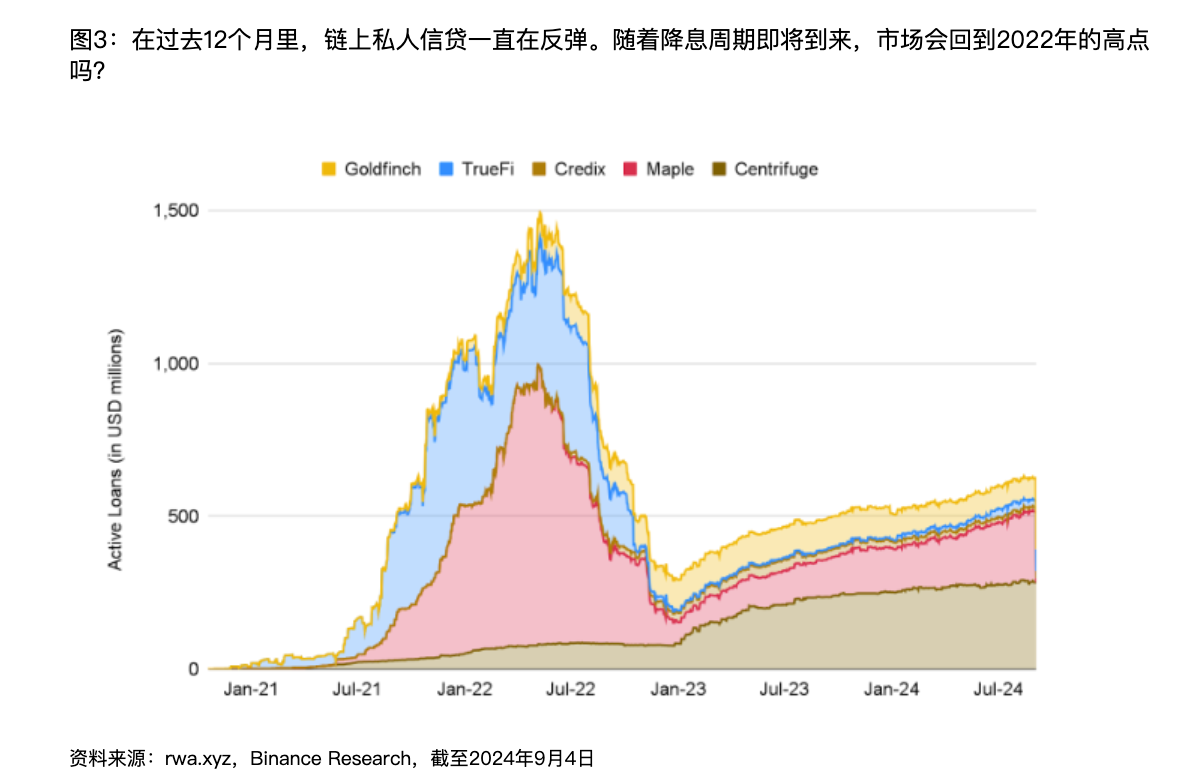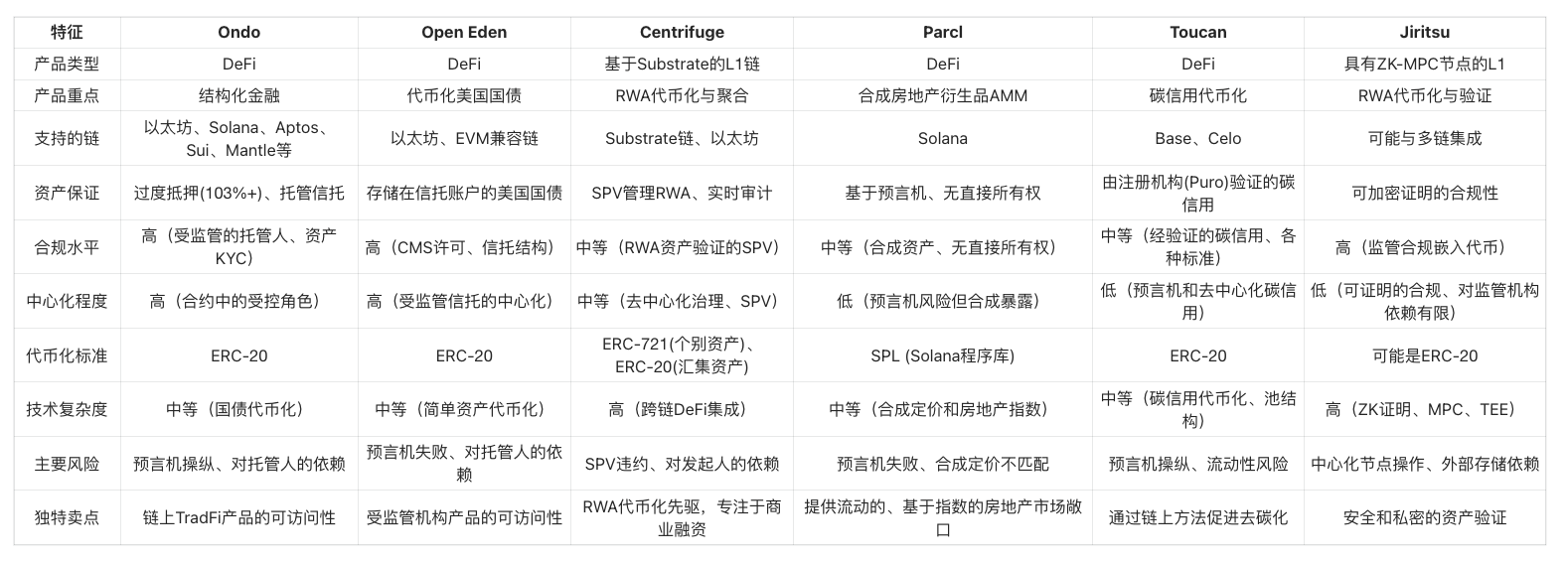原文作者:TechFlow
在这个非典型的牛市中,RWA 领域一直在默默地赚取丰厚利润。
当所有人的情绪都很容易被模因所驱动时,如果你仔细观察数据,就会发现今年迄今为止,RWA 赛道的代币表现很可能比大多数其他赛道的代币表现更好。

当美国国债成为第一大风险加权资产时,该轨道受宏观经济影响的趋势将更加明显。
近期,币安研究院发布了一份长篇报告,题为 RWA:链上回报的避风港? 它对 RWA 轨道状况、项目和收入表现进行了详细的分析。
TechFlow对该报告进行了解读和提炼,重点内容如下。

关键要点
-
链上 RWA 总规模达到 $120 亿,还不包括 $1750 亿的稳定币市场。
-
RWA 领域的主要类别包括代币化的美国国债、私人信贷、大宗商品、股票、房地产和其他非美国债券。新兴类别包括航空权、碳信用和艺术品。
-
机构和传统金融(“TradFi”)对 RWA 的参与度正在不断提高,其中贝莱德的 BUIDL 代币化国债产品处于该类别的领先地位(市值 > $5 亿);富兰克林邓普顿的 FBOXX 是第二大代币化国债产品。
-
报告中重点介绍了 6 个项目:Ondo(结构化融资)、Open Eden(代币化国债)、Pagge(代币化、结构化信贷、聚合)、Parcl(合成房地产)、Toucan(代币化碳信用)和 Jiritsu(零知识代币化)。
-
不可忽视的技术风险:中心化,第三方依赖(特别是对于资产托管),预言机的稳健性以及系统设计的复杂性,这些都值得你付出代价。
-
从宏观经济角度来看, 我们即将在美国开始历史性的降息周期,这可能会对许多 RWA 协议产生影响,尤其是那些专注于美国国债代币化的协议。
RWA 数据基础知识
聚合 RWA 定义:有形和无形非区块链资产的通证化链上版本,例如货币、房地产、债券、商品等。更广泛的资产类别,包括稳定币、政府债务(以美国政府债券即国债为主)、股票和商品。
链上 RWA 总量创历史新高,超过 $120 亿(不包括 $1750 亿以上的稳定币市场)

重点类别一:代币化国债
-
2024年呈现爆发式增长,从年初的$7.69亿增长至9月份的$2.2亿。
-
美国利率处于23年来的高位,可能损害经济增长,自2023年7月以来,联邦基金目标利率一直保持在5.25-5.5%的水平。这使得美国政府支持的国债收益率成为许多投资者理想的投资工具。
-
政府支持——美国国债被广泛认为是市场上最安全的收益资产之一,通常被称为无风险资产。
-
美联储将于本月晚些时候的 9 月 FOMC 会议上启动降息周期,因此关注 RWA 收益率在开始下降时如何演变将非常重要。

重点类别二:链上私人信用
-
定义:非银行金融机构提供的债务融资,通常面向中小型公司。
-
IMF预计2023年市场规模将超过US$2.1万亿美元,而链上仅占约0.4%,约合US$9亿美元。
-
链上民间信贷增长极快,过去一年活跃贷款增加约56%。
-
大部分增长来自于 Figure,这是一个提供由房屋净值担保的信用额度的项目。
-
链上私人信贷市场的其他主要参与者包括 Mongolge、Maple 和 Goldfinch。
-
尽管近期有所增长,但总活跃贷款仍比一年前下降了约 57%。这与美联储大幅加息不谋而合,这导致许多借款人(尤其是那些签订了浮动利率私人信贷贷款协议的借款人)支付更高的利息,从而导致活跃贷款相应下降。

关键类别 3:商品(黄金)
-
领先的两种代币 Paxos Gold ($PAXG) 和 Tether Gold ($XAUT) 在约 $9.7 亿的市场中合计占有约 98% 的市场份额。
-
但黄金ETF非常成功,市值超过$1100亿美元。投资者仍然不愿意将黄金持有量进一步转移到链上。
关键类别 4:债券和股票
-
市场规模相对较小,市值约为$80百万。
-
热门的代币化股票包括 Coinbase、NVIDIA 和 SP 500 追踪器(均由 Backed 发行)。
重点类别5:房地产、清洁空气权等。
-
尽管它尚未达到大规模采用的程度,但该类别仍然存在。
-
可再生金融(ReFi)的概念随之而来,试图将财务激励与环保和可持续的成果相结合,例如将碳排放代币化。
RWA 的关键组成部分
智能合约:
-
利用 ERC 20、ERC 721 或 ERC 1155 等代币标准来创建链下资产的数字表示。
-
主要特点是 自动收入积累机制 ,将链下收入分配到链上。这是通过 rebase 代币(例如 stETH)或非 rebase 代币(例如 wstETH)实现的。
甲骨文:
-
主要趋势: RWA 特定的 Oracle。 法律合规、准确估值和监管监督都是通用预言机可能无法完全解决的问题。
-
例如,在私人借贷中,贷方可能会在链上发放 RWA 抵押贷款。如果没有高质量的预言机来传达资金的使用情况,借款人可能不会遵守贷款协议,承担风险,甚至可能违约。

(来源:原文报道,TechFlow整理)
-
致力于专用预言机的项目:Chronicle Protocol、Chainlink、DIA 和 Tellor
身份/合规性
-
灵魂绑定令牌(“SBT”)和零知识SBT(“zkSBT”)等新兴身份验证技术提供了一种有前途的方法来验证身份,同时保护敏感的用户信息。
资产托管
-
结合链上和链下解决方案来管理:
-
链上:使用安全的多重签名钱包或多方计算(“MPC”)钱包来管理数字资产。链下:持有实物资产的传统托管人遵循法律整合,以确保适当的所有权和转移机制。
传统金融机构入局
贝莱德(资产管理规模:$10.5万亿美元)
-
美元机构数字流动性基金(“BUIDL”)规模超过 $5.1 亿,处于市场领先地位。
-
该款产品于三月底上市,并迅速成为该领域最畅销的产品。
-
Securitize 是贝莱德在 BUIDL 的重要合作伙伴,并担任转让代理、代币化平台和配售代理。
-
与此同时,贝莱德是现货比特币和现货以太坊 ETF 的最大发行人。
富兰克林邓普顿(资产管理规模:US$1.5万亿)
-
他们的链上美国政府货币基金(“FOBXX”)目前是第二大代币化国债产品,市值超过 $4.4 亿。
-
BlackRock 的 BUIDL 在以太坊上运行,但 FOBXX 在 Stellar、Polygon 和 Arbitrum 上活跃
-
区块链集成投资平台 Benji 为 FOBXX 添加了更多功能,允许用户浏览代币化证券,同时投资 FOBXX。
WisdomTree Investments(资产管理规模:$1100亿)
-
该公司原本是一家全球ETF巨头和资产管理公司,如今又更进一步,推出了多只“数字基金”,所有这些RWA产品的总AUM超过$23百万。
项目分析
-
报告中分析的项目包括 Ondo(结构化融资)、Open Eden(代币化国债)、Pagge(代币化、结构化信贷、聚合)、Parcl(合成房地产)、Toucan(代币化碳信用)和 Jiritsu(零知识代币化)。
-
报告中对各个项目的商业模式和技术实现进行了详细描述,限于篇幅,这里不再赘述。
-
各项目综合比较及特点如下:

(来源:原文报道,TechFlow整理)
总体结果和展望
-
RWA 能带来收益,但技术风险 VS 收益是否值得,则见仁见智。技术风险如下:
中心化:智能合约或者整体架构呈现较高的中心化程度,考虑到监管要求,这是不可避免的
第三方依赖:高度依赖链下中介机构,尤其是资产托管
-
一些新技术趋势:
RWA 专用预言机协议的出现。Chainlink 等知名公司也越来越关注代币化资产。
零知识技术正在成为平衡法规遵从性与用户隐私和自主权的潜在解决方案。
-
RWA 需要自己的链吗?
好处:在这些链上更容易推出新的协议,而不必建立自己的 KYC 框架和跨越监管障碍,从而促进更多 RWA 协议的增长;想要采用某些区块链功能的传统机构或 Web2 公司可以确保其所有用户都经过 KYC/满足必要的监管要求。
缺点:面临“冷启动”问题;难以引导具有流动性的新链并确保足够的经济安全性;进入门槛较高,用户可能需要设置新钱包,学习新的工作流程,并熟悉新产品
-
下次降息预期展望
美联储预计将在9月18日下次会议上开始降息周期,这对于在高利率环境下蓬勃发展的风险加权资产计划意味着什么?
虽然部分 RWA 产品的收益率可能下降,但它们仍将提供多样化、透明度和可及性等独特优势,这可能使它们继续成为低利率环境下有吸引力的选择。
-
对法律环境的担忧
许多协议仍然保持着相当程度的中心化,包括zk在内的各种技术都有很大的改进空间。
分散权力,同时仍保持法规遵从性;这可能还需要对传统合规系统进行一些改变,以识别新的验证形式。
大多数 RWA 协议还有一段路要走,才能真正为专业投资者保留金融产品并实现无需许可的访问。
本文来源:币安RWA报告解读:传统机构积极入市,降息预期下资产收益或下降
原文作者:Matthew Green 原文翻译:Block unicorn 关于作者 Matthew Green 是约翰霍普金斯大学的密码学家和教授。我设计和分析无线网络、支付系统和数字内容保护平台中使用的加密系统。在我的研究中,我研究使用加密技术保护用户隐私的各种方法。 这篇文章的灵感来自最近一则令人担忧的消息,Telegram 首席执行官 Pavel Durov 因未能充分监管内容而被法国当局逮捕。虽然我不知道具体情况,但用刑事指控来胁迫社交媒体公司是一个相当令人担忧的升级,因为事情似乎比表面上看起来的要复杂得多。但我今天不想谈论这次逮捕。我想谈谈…







